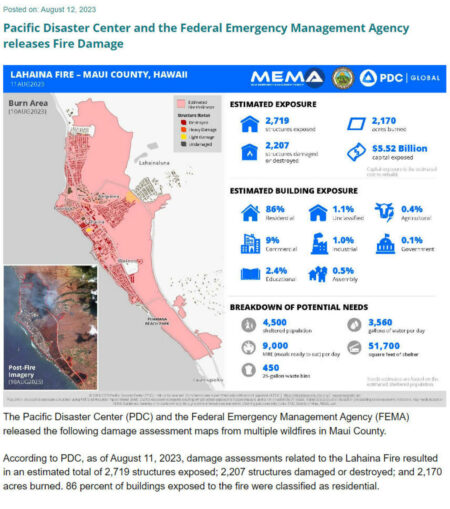Wildfires devastate Native Hawaiian lands
This week, wildfires are devastating Kānaka Maoli (Native Hawaiian) lands in U.S.-occupied Hawaiʻi. The largest fires have erupted on Hawaiʻi and Maui, Hawaiʻi’s two largest islands, burning over 2,000 acres. As of this article’s publication, 99 people are confirmed dead. At least 1,000 other people remain unaccounted for, and authorities expect the death toll to rise.

Government map shows nearly every building in Lāhainā, the capital of the Kingdom of Hawaiʻi, destroyed or damaged. (Photo websource: Pacific Disaster Center)
Many residents had no warning of the fires and had to flee into the ocean, where they waited for hours until rescue came. In all, over 11,000 residents have evacuated. These wildfires are the deadliest recorded on a U.S.-claimed territory in over a century. (New York Times, Aug 12)
Lāhainā, the capital of the Kingdom of Hawaiʻi — which was invaded and violently overthrown by the U.S. in 1893 — experienced the greatest devastation, with 2,200 structures reported destroyed. The Lāhainā region is sacred to the Kānaka Maoli, who recognize it as the birthplace of the goddess Kihwahine. (The Conversation, Aug. 11)
Cultural sites and artifacts destroyed
The buildings lost in Lāhainā include the Waiola Church, which housed the remains of several Kānaka Maoli monarchs, the Na ʻAikane o Maui Cultural Center, home to many important Polynesian and Kānaka Maoli documents and artifacts now destroyed by the fire, and Pūnana Leo, one of the few immersive Kānaka Maoli language schools still in existence.
Carmen Hulu Lindsey, chairwoman of the Office of Hawaiian Affairs said, “We have watched our precious cultural assets, our physical connection to our ancestors, our places of remembering — all go up in smoke.”
The destruction caused by the fires has worsened an already dire housing shortage for many Kānaka Maoli, who lack access to the land and its resources due to theft by the U.S. settler colonial state. While Hawaiʻi’s capitalist government spends tens of millions of dollars every year helping to build luxury resorts and beach houses for predominantly white settlers, thousands of Kānaka Maoli remain unhoused on their own lands. A Stanford Medicine study found that on the island of O‘ahu alone, Kānaka Maoli make up over 50% of the unhoused population. (tinyurl.com/5n9bb23a)
After the fires, many more Kānaka Maoli lost their homes and now lack the assistance necessary to help them rebuild. As Kūhiō Lewis, CEO of the Council for Native Hawaiian Advancement, explained, “The one thing that gave [many Native Hawaiian residents] stability — a place to stay at night for some there —they don’t even have that anymore.”
While federal aid and relief has been slow in coming to Hawaiʻi, where fires continue to rage, the Biden Administration has asked for an additional $24 billion in military aid for the proxy war in Ukraine, exposing, once more, the priorities of the U.S. militarist, imperialist state.
‘No government agency is helping us’
In the absence of an adequate government response, many Kānaka Maoli have organized their own relief efforts. On Maui, volunteers handed out food, clothes, and other supplies to survivors. “There is no government agency helping us. This is our home, our community,” said Jareth Lumlung, a Kānaka Maoli volunteer leading these relief efforts. (tinyurl.com/4kwkfpt7)
Most corporate media coverage of the fires has lamented the damage and disruption experienced by tourists and predominantly white settlers. Many articles have erased the Kānaka Maoli altogether, describing their homelands as a “tropical getaway.” Although a few reports have mentioned the climate crisis, the bourgeois press has ignored the direct role of capitalism, imperialism and settler-colonialism in causing these disasters.
Hawaiʻi’s wildfires are just some of the many blazes — sparked by record-breaking droughts, heat waves, and extreme weather — which have devastated Indigenous lands around the world. Yet, they are also the specific and direct result of the ongoing settler-colonial occupation of Hawaiʻi.
In 1893, U.S. planters and businessmen orchestrated a coup d’état that overthrew the sovereign monarchy of Hawaiʻi, dethroning Queen Liliʻuokalani and preparing the way for U.S. annexation in 1898. U.S. settler authorities stole and enclosed thousands of acres of Kānaka Maoli land and imposed a system of cash crop cultivation that decimated traditional agriculture, conservation and forestry.
On Maui, white landowners diverted waterways to irrigate sugar and pineapple plantations, draining vital reserves. Lāhainā, a lush wetland prior to U.S. colonization, has dried up. The invasive grass that replaced the native vegetation that was stripped to make way for cultivation overran fallow lands and helped fuel the recent wildfires. Today, tourist resorts, golf courses and other playgrounds for the rich continue to guzzle millions of gallons of water every year, denying Kānaka Maoli communities vital resources and environmental protections.
Protests vs. U.S. Navy ships’ toxic leaks
As previous Workers World articles have described, ongoing U.S. military occupation has caused further environmental devastation. Kānaka Maoli activists continue to protest the headquarters of the U.S. Navy’s Pacific Fleet at Wai Momi (Pearl Harbor), which has leaked tens of thousands of gallons of jet fuel and other toxic chemicals into the aquifer at Kapūkaki (Red Hill), leaving thousands of residents without clean drinking water. (workers.org/2022/01/61110/)
“Our water has been taken away from us,” said Kānaka Maoli organizer Noelani Ahia in a recent interview. “And it’s left us in this dry, barren, almost unrecognizable…condition we’re living in under the settler government. So, you combine the dispossession with the overtourism, with the overdevelopment, and you have this trifecta for disaster.” (Democracy Now, Aug. 11)
The fires in Hawaiʻi are yet another horrific consequence of capitalism, imperialism and settler-colonialism that continue to inflict environmental and human destruction on an unimaginable scale. A lasting solution to these environmental catastrophes can only come when the Kānaka Maoli, along with all other Indigenous nations worldwide, including in the continental U.S., win full sovereignty and take back their stolen lands.

